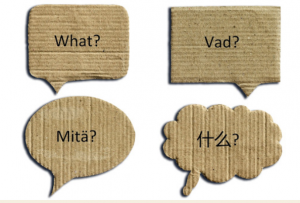Written by the group Kontula-Gårdsbacka Team
12.10.2020

University of Helsinki Material Bank
Language use is a central element to include personnel and students in the teaching and research in a multilingual university. In my own multilingual context (Swedish, Finnish, English, Danish), there are many examples of using different languages, although the use of multilingualism is not always acknowledged. This blog post will give a small example of how to include a variety of languages in daily communication, for example with colleagues.
It is possible to communicate, orally and in writing, with several colleagues in several languages. However, for multilingual communication to succeed one must agree in advance on the communication language. For example, one could agree to speak Finnish in-person, while e-mails are in Swedish and co-writing is in English. Or we could speak our own languages when we meet, but written communication is only in one language. Mobilising our colleagues and students’ lingual resources seems evident as a part of university pedagogy.
In addition, this lingual flexibility is an asset for the University of Helsinki, and supports integration of more international staff and students (Language Policy of the University of Helsinki, 2014). It should be noted that questions of global citizenship (Clifford & Haigh, 2018) and theoretical considerations on global education (e.g. McGaha, 2017) are always interwoven in highly specific local contexts and can change across cultures.
While official language policies should be integrated into the everyday life of the language users, sometimes carefully crafted instructions can be stifling. In practice, it is often the shared conventions that shape the interaction. One particularly interesting phenomenon is how the first interaction with someone shapes the future communication if there is not further focused discussion on the subject.
Maybe you have had the experience that you tend to continue with a person in the same language you used when you first met. It can be very difficult to change the language of your initial communication – it can sometimes feel that communication in another language takes place with a different person.
The context and skill associated with a particular language can also shape one’s behaviour and personality in social interaction. Limited vocabulary can result in a sense of awkwardness that disappears immediately after switching to another language. A language used mostly in casual interactions can be very difficult to transfer to professional contexts. Shared sociocultural norms have an effect on individual expression (see Wang & Moskal, 2019).
Therefore, it takes an effort but is truly valuable to consciously experiment with different combinations of languages in various settings. Rather than allowing a lingual mismatch to cause awkward silences it should encourage us to establish more straightforward and comprehensive interaction with one another and embolden us to be freerer in mixing and matching the languages we use in certain situations.
.
It is not always easy to find a common language but definitely worth trying! (Creative Commons CC0)
Original Blog for International and Collaborative Environment Course: Kontula Gårdsbacka team
References:
Clifford, J., Haigh, M. (2018). Internationalisation of the curriculum comes of age. University World News. 23 November 2018.
Language Policy of the University of Helsinki. (2014). Retrieved 1.10.2020 at https://helda.helsinki.fi/bitstream/handle/10138/160446/HY332282.pdf?sequence=1&isAllowed=y
McGaha, J. (2017). Popular Culture & Globalization: Teacher Candidates’ Attitudes & Perceptions of Cultural & Ethnic Stereotypes. Multicultural Education. 2015. Fall. 32–37.
Wang, S., & Moskal, M. (2019). What is Wrong with Silence in Intercultural Classrooms? An Insight into International Students’ Integration at a UK University. Journal of Comparative and International Higher Education. 11, 52–58.
